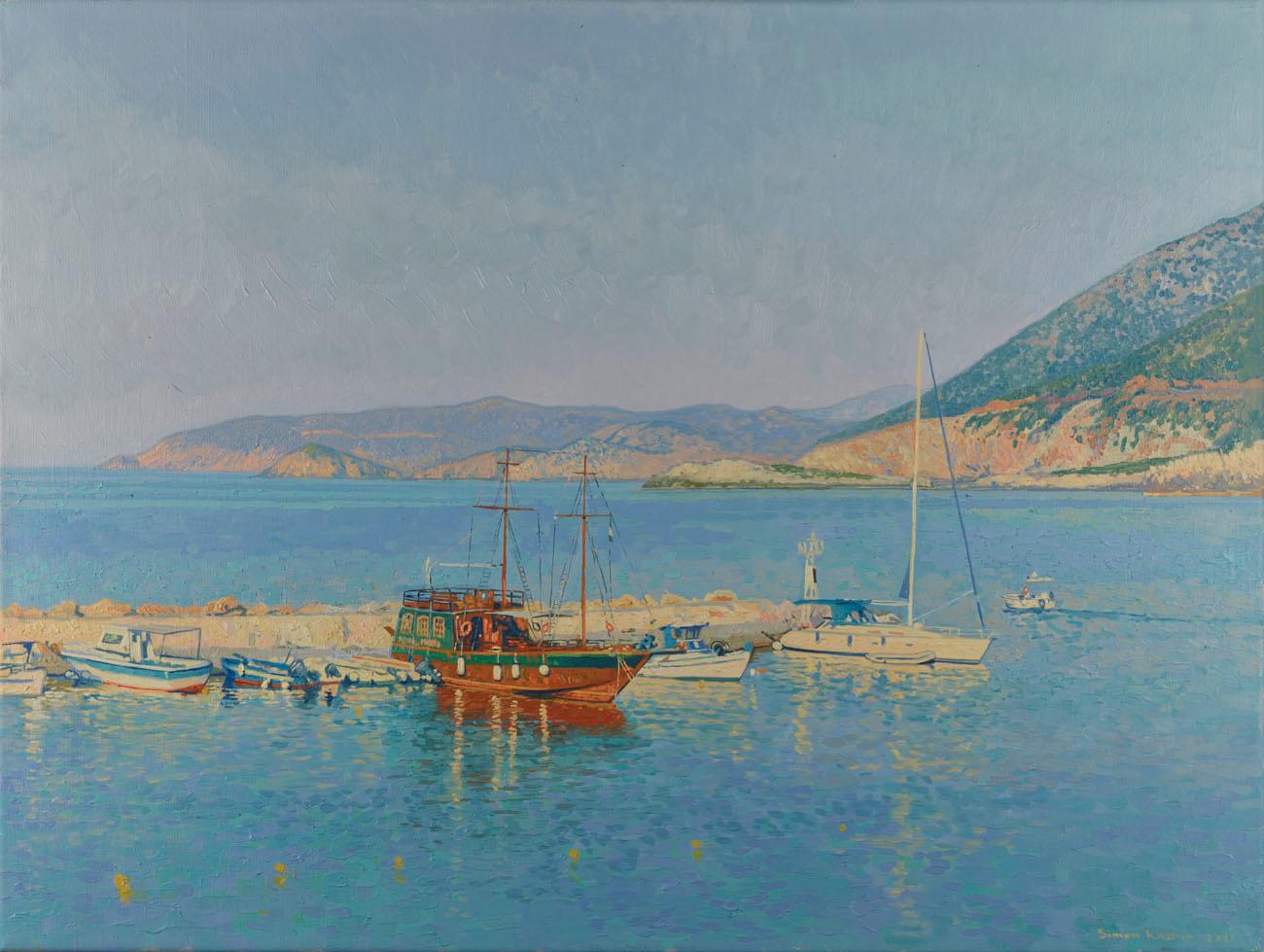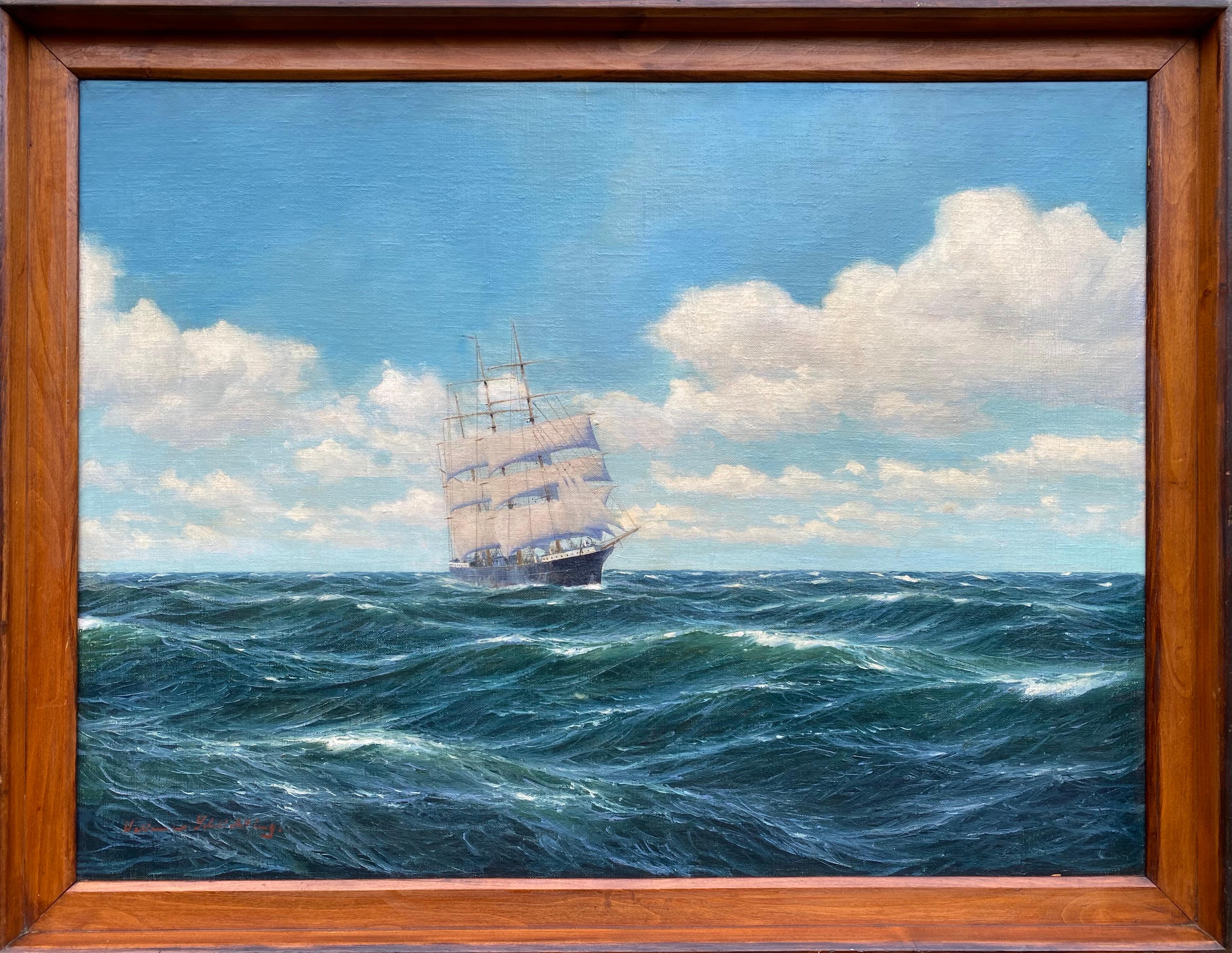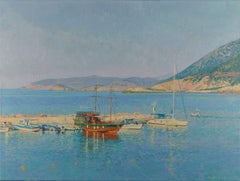Items Similar to "Filipino Girl Coming Down the Steps", 19th Century by Artist Fabian de la Rosa
Want more images or videos?
Request additional images or videos from the seller
1 of 11
Fabian de la Rosa"Filipino Girl Coming Down the Steps", 19th Century by Artist Fabian de la Rosa1894
1894
About the Item
FABIAN DE LA ROSA
Filipino, 1869 - 1937
"FILIPINO GIRLO COMING DOWN THE STEPS"
signed & dated "F. de la Rosa, 1894" (lower right)
oil on canvas
42-3/4 x 23-3/4 inches (108 x 60 cm.)
framed: 46-1/4 x 27-1/4 inches (117 x 69 cm.)
PROVENANCE
Spanish Diplomat Collector
Fabian de la Rosa y Cueto (May 5, 1869 – December 14, 1937) was a Filipino painter. He was the uncle and mentor to the Philippines' national artist in painting, Fernando Amorsolo, and to his brother Pablo. He is regarded as a "master of genre" in Philippine art.
Fabian de la Rosa was born in Paco, Manila to husband and wife Marcos de la Rosa and Gorgonia Cueto. Born to a family of artists, he was exposed to art at an early age and learned to draw well before he could write. He was trained to sketch portraits and landscapes by his aunt, Marciana de la Rosa, when he was ten years old. He also apprenticed under his uncle, Simón Flores y de la Rosa, a well-known painter of portraits and church interiors from the nineteenth century. De la Rosa lived most of his life in the Philippines and visited Europe for the first time when he was 39. He married Gorgonia Tolentino on January 13, 1900.
De la Rosa received formal education at the age of 12 when he enrolled at the Escuela de Artes y Oficios in 1881. Three years into his training de la Rosa's father died, forcing the young painter to drop out of the school in order to help feed his family. It was during this time that he painted his first known masterpiece, La Perla de Lucban. In 1893, he entered the Escuela Superior de Pintura Escultura y Grabado at the age of 24 where he received training from Lorenzo Guerrero and Miguel Zaragoza. In 1898, de la Rosa won a contest for a scholarship to Spanish Art Academy of San Fernando in Madrid. However, the outbreak of the Philippine Revolution meant his dream would not materialize.
Later under the American regime, the Escuela would become one of the three founding units of the University of the Philippines (established in 1908) and renamed the UP School of Fine Arts. In 1908, he traveled to Europe as a pensionado through a scholarship opportunity given by the Germinal Cigar Factory. He attended the Académie Julian in Paris, France.
After traveling from Europe, he became one of the first instructors at the School of Fine Arts at the University of the Philippines, where he introduced to his students the decorated form of painting. De la Rosa became the full director of the school from 1927 to 1937.
Together with his wife, de la Rosa went back to Europe in 1928, where he painted in Paris for four months. He also traveled to Munich, Germany, Geneva, Switzerland, and Rome. Upon reaching Madrid, Spain, he held an exhibit of his works at the Ateneo de Madrid.
It is believed that de la Rosa was able to paint about 1,000 works. De la Rosa's works were divided by Aurelio S. Alvero into three time periods: those that are academic but are not giving importance to atmosphere and ambience; those that have academic form that gives importance to the environment that could be sensed; and those that play with the use of colors.
Even after his death, de la Rosa was recognized and was given the Patnubay ng Sining at Kalinangan (Guide of the Arts and Culture) by the City of Manila in 1968.
De la Rosa's Transplanting Rice received the golden award at the International Exposition held in St. Louis, Missouri in 1904. It is also during this exposition when his The Death of General Lawton was awarded the bronze prize.
An exposition about the paintings of de la Rosa was held at the Jorge B. Vargas Museum of the University of the Philippines, in Diliman, Quezon City, on January 14, 2007. The presentation was given the title "Fabian De la Rosa (1869-1938) Retrospective Exhibition," and was managed by the University of the Philippines with the assistance of the Spanish Program for Cultural Cooperation, a part of Vibal Publishing House, Inc.
undefined
About the Seller
5.0
Vetted Professional Seller
Every seller passes strict standards for authenticity and reliability
Established in 1977
1stDibs seller since 2019
21 sales on 1stDibs
Typical response time: 4 hours
- ShippingRetrieving quote...Shipping from: Madrid, Spain
- Return Policy
Authenticity Guarantee
In the unlikely event there’s an issue with an item’s authenticity, contact us within 1 year for a full refund. DetailsMoney-Back Guarantee
If your item is not as described, is damaged in transit, or does not arrive, contact us within 7 days for a full refund. Details24-Hour Cancellation
You have a 24-hour grace period in which to reconsider your purchase, with no questions asked.Vetted Professional Sellers
Our world-class sellers must adhere to strict standards for service and quality, maintaining the integrity of our listings.Price-Match Guarantee
If you find that a seller listed the same item for a lower price elsewhere, we’ll match it.Trusted Global Delivery
Our best-in-class carrier network provides specialized shipping options worldwide, including custom delivery.More From This Seller
View All“An Orientalist Scene with Musicians and Dancer”, 19th C. Oil/Canvas by M. Rabes
By Max Rabes
Located in Madrid, ES
MAX RABES
German, 1868 - 1944
AN ORIENTALIST SCENE WITH MUSICIANS AND DANCER
signed "Max Rabes" (lower right)
oil on canvas
65 x 77-1/2 inches (164.5 x 197 cm.)
framed: 70-2/3 x 8...
Category
1910s Realist Figurative Paintings
Materials
Canvas, Oil
"Far Away Thoughts", 19th Century Oil on Canvas by Daniel Hernández
Located in Madrid, ES
DANIEL HERNÁNDEZ
Peruvian, 1856 - 1932
FAR AWAY THOUGHTS
signed "Daniel Hernandez" (lower right)
oil on canvas
27-1/2 x 19-1/4 inches (70 x 49 cm.)
framed: 39-3/8 x 31-1/8 inches (100 x 79 cm.)
Daniel Hernández Morillo...
Category
Early 1900s Realist Figurative Paintings
Materials
Canvas, Oil
Feria de Sevilla
Located in Madrid, ES
JOSÉ CAÑAVERAL
Spanish, 1833 - 1894
FERIA DE SEVILLA
signed "JCañaveral / Sevilla 1881." (lower right)
oil on canvas
29-1/3 x 19-1/2 inches (74.5 x 49.5 cm.)
framed: 38-1/2 x 29-1/2 inches (98 x 75 cm.)
PROVENANCE
Privated Collection, Lille, France
José Cañaveral y Pérez (Seville, 1833-Madrid, 1894) was a Spanish painter, brother of the artist Alfonso Cañaveral y Pérez. Born in Seville, he trained artistically at the School of Fine Arts in his city, later he moved to Madrid where he was a disciple of Federico...
Category
1880s Realist Figurative Paintings
Materials
Canvas, Oil
"Porte Saint-Denis, Paris", Early 20th Century Oil on Canvas by Joaquín Pallares
Located in Madrid, ES
JOAQUÍN PALLARÉS ALLUSTANTE
Spanish, 1853 - 1935
PORTE SAINT - DENIS
signed "J. Pallares" (lower left)
oil on canvas
10-1/2 x 15-3/4 inches (26.5 x 40...
Category
Early 1900s Realist Figurative Paintings
Materials
Oil, Canvas
"Florence´s Bridge", 19th Century Oil on Canvas by Antonietta Brandeis
By Antonietta Brandeis
Located in Madrid, ES
ANTONIETTA BRANDEIS
Czechoslovakian, 1848 - 1926
FLORENCE´S BRIDGE
signed "ABrandeis" lower right
oil on canvas
10-3/5 x 14-4/5 inches (27 x 37.5 cm.)
unframed
PROVENANCE
Private Collection, Barcelona
Antonietta Brandeis (also known as Antonie Brandeisová) (1848–1926), was a Czech-born Italian landscape, genre and portrait painter, as well as a painter of religious subjects for altarpieces.
She was born on January 13, 1848, in Miskovice (near Kutná Hora) in Bohemia, Austria-Hungary.[2] The first bibliographical indication of Antonietta Brandeis dates from her teens, when she is mentioned as a pupil of the Czech artist Karel Javůrek of Prague.[3] After the death of Brandeis' father, her mother, Giuseppina Dravhozvall, married the Venetian Giovanni Nobile Scaramella; shortly afterward the family apparently moved to Venice.
In the 1867 registry of the Venetian Academy of Fine Arts, Brandeis is listed as being enrolled as an art student. At this time, Brandeis would have been nineteen, and one of the first females to receive academic instruction in the fine arts in Italy. In fact, the Ministry granted women the legal right to instruction in the fine arts only in 1875, by which time Brandeis had finished her education at the Academy.
Brandeis’s professors at the Venetian Academy of Fine Arts include Michelangelo Grigoletti and Napoleone Nani for life drawing, Domenico Bresolin for landscape, Pompeo Marino Molmenti for painting and Federico Moja for perspective. Already during her first years of study there is evidence of Brandeis' skill-in her first year she is awarded prizes and honors in Perspective and Life Drawing. Brandeis’ continuing excellence and diligence in her artistic studies during the five years she spends at the Academy is attested to in the lists of prize-winning students of the Academy “Elenco alunni premiati Accademia Venezia in Atti della Reale Accademia di Belle Arti in Venezia degli anni 1866-1872”.[4] It includes numerous mentions of prizes and high honours won by Brandeis in Art History, Perspective, Life Drawing, Landscape and Anatomical Drawing, Drawing of Sculpture, and “Class of Folds”.
It is in Venice at the Academy that Brandeis perfected her skills as a meticulous landscape and cityscape painter, with intricate and luminous details in the tradition of the eighteenth-century “vedutisti”. In 1870, while still a student at the Academy, she participated in her first exhibition; that of the Società Veneta Promotrice di Belle Arti with the oil painting Cascina della Madonna di Monte Varese. She is documented as having exhibited eight paintings during the years 1872 to 1876 with the Società Veneta Promotrice di Belle Arti, both landscapes and genre scenes. In the exhibit of 1875 her landscape Palazzo, Marin Falier is sold to M. Hall of London for 320 lire, a first indication of the success Brandeis will achieve with foreign collectors of her work (particularly the English and German visitors to Italy on the Grand Tour circuit). During these same years, she showed two paintings in the Florentine exhibit Promotrice Fiorentina. The first painting, entitled “Gondola” is a subject which she repeats in new variations throughout her career with great success. The second, perhaps a genre painting, is entitled “Buon dì !” The two paintings remained unsold and were presented at the same exhibition the following year, together with two more genre scene paintings.
In 1876 and 1877 she exhibited three landscapes of Venice at the Promotrice Veneta, which sold to foreign collectors. In November 1877 Brandeis showed the large painting Palazzo Cavalli a Venezia at the exhibition of the Hungarian Fine Arts Society in Budapest. In both Florence and Budapest, Brandeis showed her work under the name “Antonio Brandeis”. The biographer De Gubernatis offers the following explanation for the change of name: “her first pictures received praise and criticism; she took the criticism, but when she was praised as a woman she was annoyed, and therefore exhibited under the name Antonio Brandeis.”
During the years 1878 to 1893 Brandeis painted and exhibited numerous works, primarily scenes of Venice, and although she resided chiefly in that city she also traveled and painted in Verona, Bologna, Florence, and Rome. As well as in Venice and Florence, she exhibited in Turin, Milan, and Rome. In 1880 she was present at the International Exposition of Melbourne with three paintings: Palazzo Cavalli, A Balcony in Venice and The Buranella- native of Burano Island near Venice.
Brandeis was a prolific painter, and often replicated her most popular subjects with only slight variations. She was represented in Venice at the photographer Naya’s studios in Piazza San Marco and in Campo San Maurizio and in Florence she collaborated with the picture dealer Giovanni Masini.
During this period of intense activity painting landscapes en plein air and genre scenes, Brandeis also is documented in De Gubernatis as a painter of religious altarpieces. Several of these altarpieces can be found on the Island of Korcula in Croatia. Two are visible in the parish church of Smokvici and of in the church of St. Vitus in Blato. In the sacristy of the Cathedral of Korcula is a Madonna with Christ Child painted by Brandeis. For the same church she also painted a copy of the central panel of Giovanni Bellini’s triptych from the Venetian Church of Santa Maria dei Frari Gloriosa (1488). In 1899, for the main altar of the chapel of St. Luke in the Korcula town cemetery, Brandeis painted a St. Luke, which shows the sparkling colors and free impasto typical of her plein air oil paintings.
On October 27th 1897 at the age of 49, Brandeis married the Venetian Antonio Zamboni, a knight and officer of the Italian Crown and knight of the Order of SS. Maurizio and Lazzaro. The couple continued to reside in Venice and Brandeis continued to show at Italian exhibitions in Venice, Florence, and Rome although more sporadically and with fewer works than before. Although she participated in the International Exposition of Watercolourists in Rome in 1906 with a “Study” and in the Società Promotrice delle Belle Arti in Florence in 1907 and 1908 with two oil paintings, De Gubernatis quotes Brandeis as saying in 1906, that even though she resides in Venice “I am a foreigner, and for some time I have not taken part in Italian Exhibitions, sending all my paintings to London.[3] Antonio Zamboni died 11...
Category
1890s Realist Figurative Paintings
Materials
Oil, Canvas
"Valencian Flower Pickers ", Early 20th Century Oil on Canvas by José Mongrell
Located in Madrid, ES
JOSÉ MONGRELL
Spanish, 1870 - 1937
VALENCIAN FLOWER PICKERS
signed “J. Mongrell” lower left
oil on canvas
29-1/4 x 45 inches (74 x 114 cm.)
framed: 42-3/...
Category
1910s Realist Figurative Paintings
Materials
Oil, Canvas
You May Also Like
Yachts in the bay of Bali, Original Seascape Mountainscape Oil Painting, Large
By Simon Kozhin
Located in Zofingen, AG
Catalogue raisonné reference:
Publisher: Tvorchestvo (2015) Language: English Russian ISBN-10: 5000280512 ISBN-13: 978-5000280515.
Artwork description
Original oil painting on canva...
Category
2010s Realist Landscape Paintings
Materials
Canvas, Oil
"Snow on HLC, Study #2 (mile-marker 20)" by Tracy Wall, Original Oil Painting
Located in Denver, CO
"Snow on HLC, Study #2 (mile-marker 20)" by Tracy Wall (United States) is an original, handmade oil painting that depicts a landscape and is framed and ready to hang.
As an artist, Tracy Wall sheds new light on everyday life, inviting the viewer to see the familiar as if for the very first time. Working with a variety of subjects, Tracy paints interesting viewpoints with compelling value, color, and shapes. Appealing compositions are everywhere, and they make strong impressions from afar even before the subject matter is recognized. She loves to balance representational impressions with more abstracted compositions.
Tracy has studied at the Art Students League of Denver under such influential artists as Michelle Torrez, Ken Velastro, Kevin Weckbach, John Lencicki, and Rob Gratiot while also participated in additional workshops from Sally Strand, Carol Marine and David Shevlino.
After starting at the University of...
Category
21st Century and Contemporary Realist Figurative Paintings
Materials
Canvas, Oil
Stones on the seashore. 1959. Canvas, oil, 50x70 cm
Located in Riga, LV
Stones on the seashore. 1959. Canvas, oil, 50x70 cm
In the artist's work, the stones on the seashore are painted with safe strokes. The color of the work is soft and saturated at the same time.
Waves are lapping in the distance.
The artist has devoted his attention to the depiction of a rocky seashore on the coast of the Vidzeme Sea, which is the eastern shore of the Gulf of Riga in the Baltic Sea.
Aleksandrs Zviedris...
Category
1950s Realist Landscape Paintings
Materials
Oil, Canvas
$1,675 Sale Price
20% Off
Threshing 1940. Canvas, oil. 54.5x73.5 cm
Located in Riga, LV
Threshing 1940. Canvas, oil. 54.5x73.5 cm
Artist painted scene of every day life of countryside people in working atmosphere - threshing and haying. There is captured two haystacks, tractor, barn, and people in working process.
Information about artist...
Category
1940s Realist Figurative Paintings
Materials
Oil, Canvas
$2,600 Sale Price
20% Off
Sailing the Waves, Waldemar Schlichting, Berlin 1896 – 1970, German, Signed
Located in Knokke, BE
Sailing the Waves
Schlichting Waldemar
Berlin 1896 – 1970
German Painter
Signature: Signed bottom left
Dimensions: Image size 61 x 81,50cm, frame size 69,50 x 89,50 cm
Medium: Oil ...
Category
Mid-20th Century Realist Landscape Paintings
Materials
Canvas, Oil
Sea. Oil on canvas and cardboard, 60x65 cm
Located in Riga, LV
Sea. Oil on canvas, 60x65 cm,
Category
1970s Realist Landscape Paintings
Materials
Canvas, Oil, Cardboard
$446 Sale Price
20% Off
Recently Viewed
View AllMore Ways To Browse
La Antique
From Philippines
Filipino Art
Four Girls Painting
American School 19th Century Portrait Painting
Spanish Girl Painting
Late 19th Century Spanish Painting
Early 19th Century American Portrait Paintings
Rosa Oil Canvas
Cigar Painting
Spanish Girl Oil Painting
Oil Painting 3 Girls
19th Oil Portrait Student
Philippines Antique
American School Oil Portrait 19th
Marco Paris Painting
St Louis 1890
Old Master Young Girls Painting




